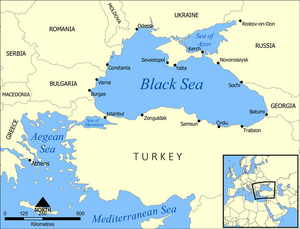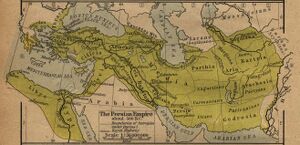Black Sea
| Author:Laxman Burdak, IFS (R) |



Black Sea (काला सागर) is a sea in south-eastern Europe.
Variants of name
- Euxine Sea (Anabasis by Arrian, p. 4, 15, 77, 94, 203, 234, 269, 313, 370, 400.)
- Euxine (Pliny.vi.13)
- Euxine Sea
- Pontus Euxinos
- Eúxinos Póntos
- Pontus Euxinus
- कृष्ण सागर (in Jāṭ Prāchīn Śāsak by B. S. Dahiya)[1]
Mention by Pliny
Pliny[2] mentions The Islands of the Euxine.... The islands of the Euxine are the Placate or Cyaneæ1, otherwise called Symplegades, and Apollonia, surnamed Thynias2, to distinguish it from the island of that name3 in Europe; it is four miles in circumference, and one mile distant from the mainland. Opposite to Pharnacea4 is Chalceritis, to which the Greeks have given the name of Aria5, and consecrated it to Mars; here, they say, there were birds that used to attack strangers with blows of their wings.
1 Already mentioned in B. iv. c. 27.
2 Mentioned in c. 44 of the last Book.
3 The one lying at the mouth of the Danube, and mentioned in B. iv. c. 27.
4 Mentioned in c. 4 of the present Book. See p. 9.
5 Or "Mars' Island," also called Aretias; at this island, in the south of the Euxine, the two queens of the Amazons, Otrere and Antiope, built a temple in honour of Ares or Mars. It is thought to be the rocky islet called by the Turks Kerasunt Ada, between three and four miles from Kerasunt, the ancient Pharnacea.
Location
It is bounded by Europe, Anatolia and the Caucasus and is ultimately connected to the Atlantic Ocean via the Mediterranean and the Aegean Seas and various straits. The Bosphorus Strait connects it to the Sea of Marmara, and the Strait of the Dardanelles connects that sea to the Aegean Sea region of the Mediterranean. These waters separate eastern Europe and western Asia. The Black Sea is also connected to the Sea of Azov by the Strait of Kerch.
Formation
Black Sea forms in an east-west trending elliptical depression which lies between Bulgaria, Georgia, Romania, Russia, Turkey, and Ukraine. It is constrained by the Pontic Mountains to the south, the Caucasus Mountains to the east and features a wide shelf to the northwest. The longest east-west extent is about 1,175 kilometres.
History
Strabo's Geography (1.2.10) reports that in antiquity, the Black Sea was often just called "the Sea" (ho pontos). For the most part, Graeco-Roman tradition refers to the Black Sea as the 'Hospitable sea', Euxeinos Pontos (Εὔξεινος Πόντος). This is a euphemism replacing an earlier 'Inhospitable Sea', Pontos Axeinos, first attested in Pindar (early fifth century BCE,~475 BC). Strabo (7.3.6) thinks that the Black Sea was called "inhospitable" before Greek colonization because it was difficult to navigate, and because its shores were inhabited by savage tribes. The name was changed to "hospitable" after the Milesians had colonized the southern shoreline, the Pontus, making it part of Greek civilization.
It is also possible that the name Axeinos arose by popular etymology from a Scythian Iranic axšaina- 'unlit,' 'dark'; the designation "Black Sea" may thus date from Antiquity.
Important cities
Important cities along the coast include Batumi, Burgas, Constanța, Giresun, Hopa, Kerch, Mangalia, Năvodari, Novorossiysk, Odessa, Ordu, Poti, Rize, Samsun, Sevastopol, Sochi, Sukhumi, Trabzon, Varna, Yalta and Zonguldak.
External links
References
- ↑ B. S. Dahiya's Jāṭ Prāchīn Śāsak (Hindi, 1982); see, p.23.
- ↑ Natural History by Pliny Book VI/Chapter 13

